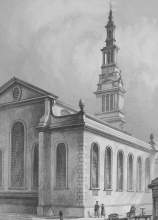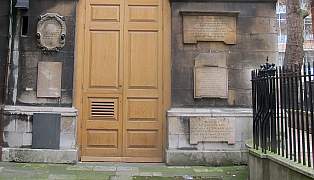 Christ Church, Newgate Street, as it was in the late 19th C.
Christ Church, Newgate Street, as it was in the late 19th C.
The ruins of a Wren church with a fine steeple, and what is left of the walls enclosing a garden, just to the north of St Paul's.
 Christ Church, Newgate Street, as it was in the late 19th C.
Christ Church, Newgate Street, as it was in the late 19th C.
Christ Church Greyfriars, Newgate Street has particular interest (as ever, entirely tangential to the purposes of these pages) as having been built on the site of the church of one of the more important London monasteries. The Grey Friars, of the Franciscan order of monks, settled in Canterbury and London from 1224, and on this site established a monastery with a fine library and a large church, 300 ft in length and just under 90 ft wide, paved and pillared with marble. In it were buried many noble people, including the founder, Queen Margaret (d.1317), wife of Edward I, another queen, Isabelle, wife of Edward II (buried with her husband's heart on her breast) and a total of nine alabaster and marble tombs in the choir. Alas, these were destroyed along with '140 gravestones of marble' and the materials sold during the Reformation by a certain Sir Martin Bones, goldsmith and Alderman. Christ’s Hospital, a school for young children, was then established on the site (the precursor of the institution set up in Horsham, Sussex at the end of the 19th Century). After the Great Fire, Christopher Wren rebuilt the church (1687-1704, when the tower was finished), which though large, was barely half the size of the original. It was described at the very beginning of the 19th Century as:
'The Fabrick is of Stone, spacious and beautiful, with Buttresses on the Out-side, and adorn’d with Acroteria, Pine-Apples, Pediments, &c., the Spire was finish’d in 1704, which is likewise of Stone, adorn’d with Vases, &c., the Roof of the Nave of the Church is camerated, and those of the two Side-Ailes are flat… the Church is ornamental and pleasant, the inside of the Roof and uppermost Windows are embellish’d with Cartouches, Cherubims, &c., of Fretwork...’‘The Oak Pulpit finely finnier’d and especially the Carving is curious where on one small Pannel is carved Our Saviour and 12 Apostles at the Last Supper, and, on the other, the four Evangelists, all in Basso-Relievo… neat Marble Font and wooden Cover, the first adorned with Cherubims, the latter with an Angel carved. Pannels surrounded with Frames neatly carved, and the whole adorned with Festoons, Fruit, Leaves, Corn-ears, &c., over which is in Fret-work Pedroits, Cartouches, Cherubims, Shields, Palm-branches, the Queen’s Arms, &c.’Other 19th Century sources comment on the many modern tablet monuments, including an ancient tablet to the philanthropist Dame Mary Ramsey, d.1596, transferred from the pre-Fire building. A black marble monument to Venetia Digby, d.1633, was largely destroyed in the Fire, but it is told that a copper-gilt bust of the deceased lady survived, being placed in a shop in Newgate Street until it was eventually melted down. Later tablets included monuments to Revd. Joseph Tripp, d.1747, Sir John Bosworth, d.1756, Chamberlain of the City of London, and his wife, Dame Hester, d.1749, and John Stack, d.1781, a wealthy painter who left large charitable bequests. Also 19th Century monuments including a bust of Revd. Samuel Crowther (1829), and another of Revd. Michael Gibbs, d.1882.
Photos from before WW2 show a sense of dark richness to the interior, with lots of fine dark woodwork, much carved, and an arched ceiling. However, this splendid interior, and our monuments, were utterly lost in the Blitz, and what we see today is the sturdy tower, which survived intact, almost all of the wall of the northern aisle, and one bay of the southern one. The charming rose garden laid out by the Corporation of London is planted to match the old floor plan, with hedges where the pews were, and wooden structures for roses and clematis to climb where some of the Corinthian pillars were. The (West) frontage of the church towards the tower shows us the height and position of the nave roof. From across the road, then, we get something of an impression of the whole church. It is large for a City Church, 114ft long and 81ft wide – and the fact that Wren’s church plan is only half the size of the original monastic church indicates something of the grandeur the Grey Friars attained in their prime.
On the western side, a low brick building has been built up against the wall, in imitation of an original outbuilding on this side, and with the surviving west wall, the appearance from this angle is not so different from pre-War views of the church from this side. Also on the west is the remnant of the churchyard, now with an iron railing around it, and enclosing a couple of tomb chests in a corner.

Surviving panel memorials, and the Hawes Monument, 1700.
Against the outside wall of the tower are half a dozen panels by the door, wall tablets which seem to have been moved here from Christ's Hospital rather than being from Christ Church itself and surviving the bombing, and one slate panel noting that the Wren’s steeple of 1691 was damaged in the bombing, and was re-erected in 1960 through the initiative of Lord Mottistone, Architect, with several public bodies contributing the bulk of the funding, but with the 12 urns at high level reinstated through a benefaction of Mrs A M Moore of Leicester.
The tablets are very plain bar one fine, small cartouche with a delicate scrolling border, to the memory of ‘Nathaniel Hawes eqs, Late Citizen of London, and for near the space of 15 years the Carefull and faithfull Treasuror of Christ’s Hospital’, d. 1700, the text being in an elegant script. We also note the plain panels in stone to John Webb, d 1830 and his wife Maria d.1846, of Sutton in the Surrey, and more modestly-sized above, John Webb, d. 1798, just 9 months old, youngest son of Daniel Webb of Audley Square and grandson of Daniel Webb, ‘late Treasurer of this Hospital’. Also John Perry, d.1785, Steward to the Hospital; John Mallcott, d.1766, Citizen and Mayor of London, Christian and Tradesman, a plain marble tablet with a shelf; and the oldest tablet, to Mr Thomas Firmin d.1697, 'Late Citizen of London, and one of the Governours of this and St Thomas’ Hospital', with an inscription noting his important charitable works towards orphans and the distressed.
The surviving Wren tower, end of Nave with garden, and wall of northern aisle.
The site is on the corner of Newgate Street and King Edward Street by St Paul’s. Just along Newgate Street is St Sepulchre, where Wren kept the large dimensions of a pre-Fire church, which is thus the largest now extant of the City Churches. And a few minutes stroll up King Edward Street is Postman’s Park, the evocative garden which inspired by G. F. Watts was laid out in 1899 with Doulton tile plaques to commemorate civilian lives lost in acts of heroism.
View from the Western end, early 19th C.
Go west to St Sepulchre // or west and south via Old Bailey // to St Martin's Ludgate // or east to St Mary le Bow // or to St Augustine Watling Street
City Churches // Christopher Wren // London sculpture // Sculptors // Introduction to church monuments
Visits to this page from 13 Mar 2014: 9,590